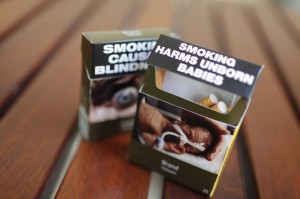
Last week I was lucky enough to attend the 15th Annual World Conference on Tobacco or Health in Abu Dhabi. With both Ireland and the UK announcing in the weeks leading up to the conference that they would implement plain (or ‘standardised’) packaging of cigarettes, it wasn’t surprising that this was one of the conference’s hot topics.
One of the sessions that focused on plain packaging was organised by Professor Melanie Wakefield’s team at the Cancer Council Victoria in Australia. As the first country in the world to introduce plain packaging, Australian data on its real-world effectiveness is of keen interest to policy-makers worldwide.
These researchers published a supplement to the journal Tobacco Control last week, including 12 new studies on plain packaging in Australia (more details about each of the 12 studies and their methodologies are given at the end of this blog). The majority of these used a ‘pre-post’ methodology, which means that they assessed behaviours and attitudes to smoking before plain packaging was introduced and compared with these same attitudes and behaviours afterwards.
At their conference session, some of these studies were discussed in more detail, with one in particular (Durkin et al., 2015), which investigated the impact of plain packaging on quitting-related cognitions, catching my attention. This study seemed like the logical extension of my most recently published paper on plain packaging, which reports the results of randomising UK smokers to use either a branded or a plain pack of cigarettes for a day and measuring smoking behaviour and attitudes to smoking and quitting.
As I’ll discuss later on, it’s important that we use a range of methodologies, including laboratory based experiments (such as those I’ve conducted) and real-world investigations (such as those conducted by the Australian researchers) to investigate the possible impact of plain packaging.

Plain (or ‘standardised’) packaging would mean standardising the size, shape, colour and method of opening of all tobacco products.
Methods
Data for this study were obtained as part of a continuous cross-sectional telephone based survey. Participants were called twice, one month apart, first for a baseline survey and then for a follow-up. Participants were aged between 18 and 69 and all participants were required to be cigarette smokers at the baseline call.
All calls were made between April 2012 and March 2014 and participants were split into 4 groups according to when their two phone calls were made:
- Those who had both their baseline and follow-up phone calls before plain packaging was introduced
- Participants’ baseline call was made before plain packaging was introduced and their follow-up was during a transitional period where both plain and branded packs were available for purchase
- Baseline phone calls were made during the transitional period, whilst follow-up calls were made either during the transitional period or after plain packaging had been fully implemented (November 2012)
- Both baseline and follow-up calls were made within the first year of plain packaging being fully implemented
At both the baseline and follow-up stages, participants were asked about quitting related cognitions, micro-indicators of concern and quit attempts. Logistic regression was used to analyse the data and participants’ baseline scores were included as predictors for their follow-up scores (after accounting for potential confounders). Essentially, this means that follow-up scores between participants in the four groups could be directly compared, accounting for any differences at baseline. Responses from participants in Groups 2, 3 and 4 were compared with those of the participants in Group 1.
Results
In total, 5,137 participants completed both the baseline and follow-up calls. At follow-up, approximately 6% of participants across all groups had quit smoking. The following results were found for each of outcome measures:
Quitting related cognitions
- No differences in thoughts about quitting, or plans to quit in the next month were observed between the groups. However, higher intentions to quit were observed among those in Group 3 as compared with those in Group 1
Micro-indicators of concern
- Participants in Groups 3 and 4 were more likely to conceal their pack than those in Group 1
- Those in Group 4 reported higher levels of stubbing out cigarettes early than those in Group 1
- Higher rate of forgoing cigarettes were observed amongst participants in Group 2 than Group 1
Quit attempts
- More quit attempts were reported among participants in Groups 2 and 4 as compared with those in Group 1

Given that results are likely to be closely scrutinised by researchers, policy makers and the tobacco industry, it is important to carefully consider their implications and not overstate the findings.
Conclusions
This study provides modest statistical evidence that plain packaging in Australia has increased micro-indicators of concern, increased quit attempts and increased some quitting related cognitions among smokers.
The authors describe the outcomes they measured in the current study as being ‘downstream’ from the more immediate effects of plain packaging, which they have found evidence for in their other studies. These include:
- Increased noticing of the health warnings
- Reduced appeal ratings of the packs
- Reduced misconceptions about the harm of tobacco products
It is possible that more substantial changes in the downstream effects such as those measured in this study may take longer to emerge.
Plain packaging: putting these results in context
Investigating the impact of plain packaging in the ‘real-world’ using this pre-post technique has its limitations. Unlike the laboratory, the real-world isn’t tightly controlled and although the researchers tried to account for other factors which may have influenced the results, such as changes in the price of tobacco and other tobacco control measures such as mass media campaigns, it’s impossible to completely control for the effect of these, making causal interpretations difficult.
Obviously we cannot randomise whole countries to either introduce or not introduce plain packaging (which would address these limitations), and examine what happens to smoking prevalence in these countries. Studies like that by Durkin and colleagues are therefore probably the best that we can do in the real world. Moreover, no one piece of research will give us the full picture when it comes to the potential impact of plain packaging.
Although, on their own, these findings do not provide overwhelming support for a beneficial impact of plain packaging, when they are considered together with the other studies in the Tobacco Control supplement, and with data from the Australian government (which this year reported record lows in tobacco sales and smoking prevalence) along with findings from laboratory-based experiments and surveys, the evidence looks more compelling.
Now that both the UK and Ireland have announced plans to introduce plain packaging in May 2016, with other countries likely to follow suit, it will be important to continue to monitor the longer-term impacts of this tobacco control measure, making use of the wide range of research tools and methodologies available to us.

Plain packaging will be introduced in the UK and Ireland in May 2016.
Links
Primary study
Durbin S, Brennan E, Coomber K, Zacher M, Scollo M, Wakefield M. Short-term changes in quitting-related cognitions and behaviours after the implementation of plain packaging with larger health warnings: findings from a national cohort study with Australian adult smokers. Tobacco Control 2015;24:Suppl 2 ii26–ii32 doi:10.1136/tobaccocontrol-2014-052058
Other references
Research papers included in the Tobacco Control plain packaging Supplement:
Two paper-based surveys of adolescents:
Six telephone survey-based studies:
- Reponses to the health warnings
- Changes in quitting-related cognitions (the primary study discussed here)
- Relationship between responses to plain packaging and quitting-related cognitions
- Changes in types of cigarettes smoked after plain packaging
- Prevalence of illicit tobacco use
- Changes in tobacco purchase locations
One in-depth interview:
One analysis of tobacco retailer journals:
Two observational studies:


RT @Mental_Elf: New evidence on the effects of plain cigarette packaging in Australia http://t.co/1HSM7nGFoQ
New evidence on the effects of plain cigarette packaging in Australia: Olivia Maynard considers the implicatio… http://t.co/Fdbgcd5QqS
New evidence on the effects of plain cigarette packaging in Australia http://t.co/3HZWkaT8bs #MentalHealth http://t.co/fX7ITsGAlT
Olivia Cialdi liked this on Facebook.
Today @OliviaMaynard17 blogs brilliantly about the @TC_BMJ special issue on plain cigarette packaging http://t.co/1HSM7nYgNq
Great blog Olivia!
As you say, it’s important not to get carried away with these findings, but it’s promising to see these results from down under in advance of the law change here in the UK next year.
I’m interested in finding out more about your recent RCT on plain packaging. Can you tell us more and also explain why it’s so important that we use a variety of different research designs to answer the questions we have about plain packaging?
Cheers, André
“Modest evidence…plain [cigarette] packaging in Australia has…increased quit attempts” http://t.co/NYO6XiHPu3 via @Mental_Elf
Bethan Davies liked this on Facebook.
New #evidence on the effects of plain #cigarette #packaging in Australia http://t.co/zsrDvA1OrF
Are plain cigarette packs a good idea? New research provides modest evidence for them http://t.co/1HSM7nYgNq @OliviaMaynard17
RT @Mental_Elf: Are plain cigarette packs a good idea? New research provides modest evidence for them http://t.co/8jxrP9M17C @UCL_CPU
My new @Mental_Elf blog on impact of plain packs in Aus & the importance of using multiple methods to assess effects
http://t.co/sHs3yHvTgO
Mosaic Training Consultancy Ltd liked this on Facebook.
New evidence on the effects of plain packaging in Australia http://t.co/53gTG0Slt2
Hampshire Healthcare Library Service liked this on Facebook.
Mental Elf: New evidence on the effects of plain cigarette packaging in Australia http://t.co/ZvtAFMLS6M
Don’t miss: New evidence on the effects of plain cigarette packaging in Australia http://t.co/1HSM7nYgNq #EBP
“New evidence on the effects of plain cigarette packaging in Australia” http://t.co/9wLYUQQNHP
The decision to quit smoking and have the motivation to stick to it is not trivial, it requires a non-trivial shift in world view to start with, since it requires overcoming our commitment biases.
I don’t smoke, but a majority of Australians I know are either:
(a) non smokers with no intentions to smoke for whatever reason (usual justifications are money and health)
(b) Those who gave up smoking. Anecdotally, there seems to be a pattern of repeated attempts to quit until someone has some sort of personal crisis, which can be health-related, even if it isn’t smoking-related.
(c) smokers who want to quit, but have never been successful after trying. Typically, they quit for a while but start up again if/when they experience stressful events (eg friends used to start smoking again before exams).
[…] and combat the negative effects of tobacco use. These approaches include warning labels and plain tobacco packaging, media campaigns and smoke free […]